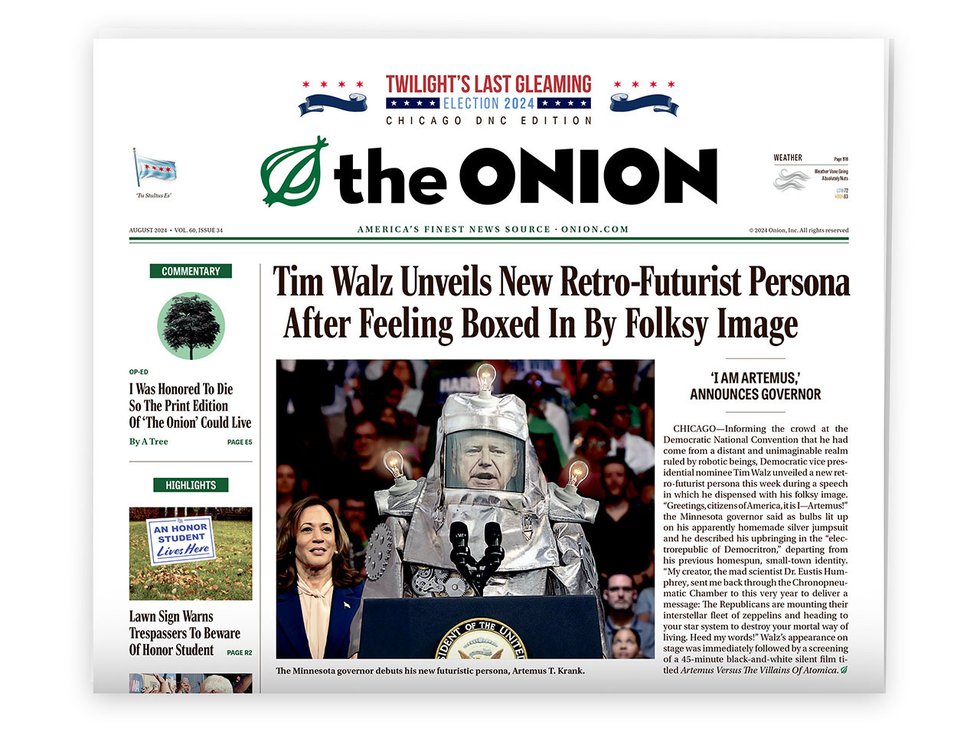Print makes a comeback – Isthmus


A few of our loyal readers sent me the news that The Onion had returned to print.
“Turns out Isthmus is once again ahead of the curve,” one wrote.
“The Onion is following your model and will now have a print edition once a month,” wrote another.
The popular parody newspaper that was founded in Madison in 1988 by two UW-Madison students did indeed return to print in mid-August, 11 years after it went online-only. Based in Chicago, the paper took the opportunity to distribute the inaugural print edition at the Democratic National Convention. From here on out, the paper will be mailed exclusively to those who subscribe.
The Onion’s return to print this spring followed another ownership change at the media outlet; Global Tetrahedron (a humorous reference to a menacing fictional company in The Onion’s 1999 book Our Dumb Century), owned by tech executive Jeff Lawson, bought the company in April from G/O Media. “The world needs laughter; it needs satirical criticism more than ever,” Lawson told the New York Times. “And that’s why we think this is the right time and the right way to help The Onion continue to grow, continue to flourish, and frankly I’m concerned if we hadn’t done this, I don’t know what would have happened.”
Jordan LaFlure, the executive editor of The Onion, says a number of factors drove the decision to return to print. “Internally to the editorial department, we’ve long regarded the print product as the superior way to consume The Onion. That’s true for any publication, but particularly true for a comedic one.”
LaFlure says that The Onion had grown increasingly reliant on social media to generate traffic. “Besides it just being a toxic, awful place to spend time, it’s not an ideal place to consume The Onion because our posts were competing with posts from your family and advertisements from shoe companies,” he says.
Print avoids those distractions. “A lot of the humor of The Onion can be found in the contrast between jokes, or the relationship between multiple jokes,” says LaFlure. “Having a bit of a walled garden for people to enjoy and play around in we just think is a better experience for the reader and a better way to also understand what we’re trying to do with satire.”
Making money was a driver, too. “While we’re still generating revenue from [our website] and intend to do more as we get back on our feet here, it’s just smarter to have a more diverse set of revenue streams,” says LaFlure.
He says the core tasks of producing The Onion for online and print consumption are the same — “we are just generating headlines and drafting the copy to marry to those headlines.” But now, he adds, “we are thinking about pacing and content diversity and what the experience is from start to finish, not to mention the design elements, which are their own special pleasure.”
Like Isthmus, The Onion doesn’t have enough staff to put out weekly issues at this time. But LaFlure sees some benefits to the less frequent schedule. “We felt a monthly would offer us a nice return to being a hair less timely,” he says. “We are not abdicating our responsibility to speak truth to power or to speak on political topics.” But, he adds, timely political content “hits harder and is richer when it’s paired with this less timely content.”
The Onion is not the only publication that has recently rebooted in print.
Spin magazine announced on Aug. 28 it would publish quarterly in print. “It’s exciting to see others like The Onion, Nylon and even LIFE going back into print. In today’s noisy digital ecosystem, print plays a fun and new role for all readers of all ages,” Spin CEO Jimmy Hutcheson said in a statement. The magazine will be sold at record and book stores and readers can subscribe as well for home delivery. Playboy magazine also recently announced it would start publishing an annual print edition, starting in February 2025.
Closer to home, the Chicago Reader, which became a nonprofit in 2022, recently announced it was returning to a weekly publishing schedule after going biweekly in 2020. Publisher Solomon Lieberman noted several reasons for the move, including wanting to keep readers better informed about upcoming elections and because “there’s more money to be made. By publishing weekly we will become a ‘paper of record’ again, allowing us to accept public notices, a consistent stream of dollars that could alone cover the increased printing costs.” Advertisers, Lieberman added, say that a “weekly cadence” better serves their needs.
And while this doesn’t count technically as a return to print, the Minneapolis Star Tribune recently announced that it would be expanding statewide and changing its name to the Minnesota Star Tribune.
Are these examples reflective of a greater trend? Is it time to retire the prediction that print is dead or dying?
The Washington Post, in its coverage of The Onion’s return to print and the Star Tribune’s expansion, put the news in the context of other recent downward trends. “Newspaper circulation has fallen in recent years, revenue has plummeted and technological advancements have disrupted the market,” Niha Masih wrote. Also, “There are 204 counties in the United States without any local news outlet; newspapers are disappearing at an average rate of more than two a week; and overall employment at newspapers has dropped by more than 70% since 2005, a report from Northwestern University found last year.”
The Star Tribune’s news notwithstanding, it seems to me like print is working less well for larger-circulation legacy newspapers than it is for more intensely local, community-focused and niche publications. Of the roughly 120 publications that are either full or affiliate members of AAN Publishers, a group founded by and still largely dominated by alt-weeklies, about 65% still have print editions, according to executive director Todd Stauffer.
For Isthmus, the print edition is both our biggest revenue generator and, we believe, an essential platform for our content. Like The Onion’s LaFlure, we believe our mix of hard news, arts coverage and general features works best taken in together.
Sue Robinson, a journalism professor at UW-Madison, looked at some recent data on print and found the numbers “startling.”
Just last year, she says, more than 70 new print magazines launched in the United States, according to the data company Statista. Also, according to the Association of Magazine Media, three-quarters of American adults had read a print magazine in the last six months of 2023. Perhaps most surprising, people under 45 were the ones most likely to be doing that reading!
At the same time the “slow media movement” has been gaining ground, adds Robinson. “The genesis behind the slow media movement is a reaction against this surplus of digital information that surrounds us in chaos,” she says. “So the idea of being able to take an Onion or Isthmus and read it by the lake Sunday morning — that is very appealing to a lot of people and not just to the typical white, older-generation, educated newspaper reader. So we’re starting to see this throughout the demographic, which I think is so exciting.”


